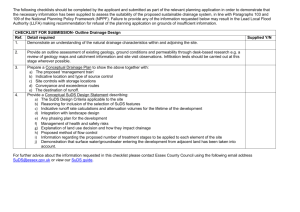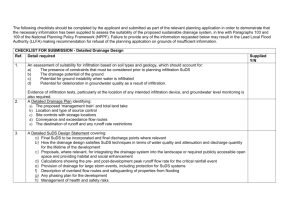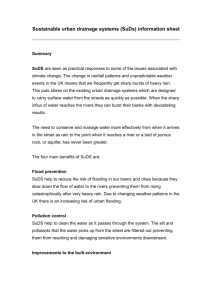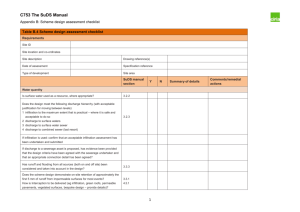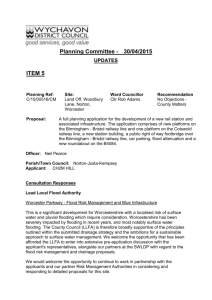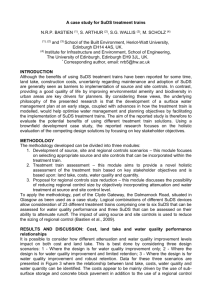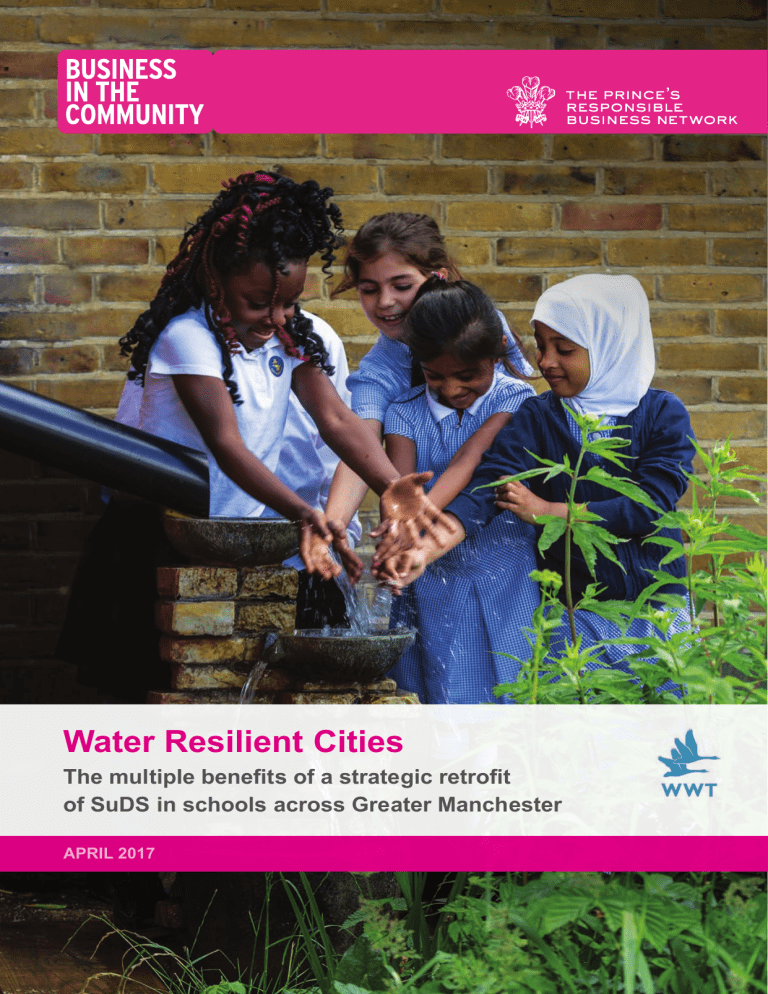
Destiny should not be determined by Demography Building alignment between the classroom and the boardroom Water Resilient Cities The multiple benefits of a strategic retrofit of SuDS in schools across Greater Manchester APRIL 2017 New research on the impact of partnership between schools and businesses Acknowledgements Thanks to ARUP, CLASP, Marshalls, MWH, Sustainable Healthcare and United Utilities for their time and expertise in supporting the project. Particular thanks to Ailsa, Bruce Horton and Chris Digman, Peter Holt and Lan Huang for their essential help in creating the scenarios and carrying out the analysis. Thanks to Hannah Freeman, WWT, for producing the report and Katie Spooner and BITC for leading on the water resilient cities project. Thanks to the Environment Agency for funding this project. Partners Cover photo: Sacha Dench, WWT 1 | ACKNOWLEDGEMENTS Sustainable drainage systems reduce the volume and speed of surface water run off potentially reducing surface water flood risk. If designed to reflect natural processes they can improve water quality and enhance biodiversity. They can offer safe, green-blue spaces with great opportunities for outdoor learning, with direct application for learning about the water cycle and the environment. As green-blue spaces they can increase health and well-being and productivity as well as removing air pollutants and sequestering carbon. A SuDS programme rolled out across Greater Manchester could realise these benefits in a cost-effective way. Costs could be recouped and financial returns seen within ten years along with valuable benefits for the community. INTRODUCTION | 2 Changing cities Cities across the UK face flooding, drought, water pollution and health problems connected with lack of access to greenspace and a decline in nature. These problems are expected to be multiplied by climate change, population growth and urbanisation. Sustainable drainage systems (SuDS) offer part of the answer to these problems. Climate change SuDS can: Climate change is expected to cause more intense, heavy rainfall events and increasing likelihood of surface water flooding. OFWAT estimates that nationally about half the average annual flooding incidents (between 5,000 and 7,000) are a result of the capacity of the drainage system being exceeded. •manage surface water runoff by using and mimicking natural processes to slow the flow of water2 •manage volume and flow rates of run-off to reduce the downstream flow and destructive power of surface water and reduce the risk of flooding •improve water quality by filtering out pollutants, reducing pollution locally and downstream in streams, rivers and estuaries •encourage natural groundwater recharge to help maintain river and stream flows in periods of dry weather and support wetlands in the wider landscape •provide water for different uses and reduce the urban heat island effect •often be attractive and good for biodiversity if designed appropriately Population growth The UK population is projected to increase by 9.7 million over the next 25 years (from 2014) requiring increases to housing and drainage capacity. The UK government has committed to building 200,000 new homes by 2020. Urbanisation 83% of the UK population lives in an urban environment1. Urbanisation replaces vegetated surfaces, which provide shading, evaporative cooling, and rainwater interception, storage and infiltration functions, with impervious built surfaces. SuDS can provide areas within the built environment where these processes can take place. A combination of retrofit SuDS measures, from an individual property level up to catchment scale, is likely to prove the most effective and financially viable alternative to traditional sewerage. 1 World Data Bank (accessed 5/4/2017) urban population 2 3 | CHANGING CITIES Woods Ballard, B. (2015) The SuDS Manual V5, CIRIA Context However, there is no national driver to encourage the retrofit of SuDS, where the opportunity for reducing surface water runoff is even greater. This has resulted in an ad hoc approach to retrofit with little funding or consideration in the planning system. As new development is only a small percent of our current building stock, SuDs retrofits could add value to existing city level plans, including those for green infrastructure. Regionally, cities have developed a number of plans such as green infrastructure plans and surface water management plans to which retrofit SuDS could be a valuable contributor. A number of water companies currently charge for surface water drainage and OFWAT has encouraged all to charge for this service according to impermeable site area. The water company, United Utilities operates a model that charges non-domestic customers for surface drainage. As a result, there are currently over 1,000 schools across Greater Manchester paying together over £4.3m in surface water charges per year. This model is specific to United Utilities but OFWAT have asked all companies to account for surface water drainage charges. Where surface water drainage charges are applied, they can provide a financial incentive for SuDS but there are also extensive societal benefits which could accrue from a wide roll out of retrofitted SuDS. Societal benefits are not monetary and disperse over a wide range of beneficiaries. Such financial and multiple benefits will only be achieved when delivered at scale as part of a strategic city-wide investment. Individual schools do not have the capacity or reach to optimise these impacts. Innovative financing mechanisms could provide the investment needed for a scalable programme that ensures that Greater Manchester and other cities can benefit from both the financial and multiple benefits of a SuDS programme. SuDS offer a great opportunity not only to reduce the risk of surface water flooding but to reconnect people to nature – a proposed Government ambition. SuDS can provide habitats in the urban environment where wildlife can thrive – let’s not just apply the Government’s commitment to leave the environment in a better state than it found it to the rural environment, let’s make the urban environment rich in bird song, buzzing bees, flowers, ponds and trees which everyone can enjoy. “ SuDS offer a great opportunity not only to reduce the risk of surface water flooding but to reconnect people to nature... “ National policy promotes the integration of sustainable drainage systems within large new developments, acknowledging the significant role they have to play in reducing the amount of surface water runoff and subsequently surface water and sewer flooding. Photo: Ed Waldron, WWT http://webarchive.nationalarchives.gov.uk/20130103130953/http:/archive.defra.gov.uk/corporate/consult/ surface-charges/20100712-drainage-response-summary.pdf CURRENT SITUATION | 4 The benefits We analysed potential benefits from a strategic roll out of retrofit SuDS in schools across Greater Manchester, having investigated the time taken to pay back the capital costs through savings made from reduced surface water charges. A number of scenarios were constructed including one based on all schools in Greater Manchester together with all health centres. For each scenario assumptions were made around two options. The most likely options were based on what an average SuDS project might look like and best case options assumed that design was optimised to achieve multiple benefits, for example by planting more trees3. The multiple benefits were then calculated using the CIRIA BeST (Benefits of SuDS Tool). • A strategic roll out of SuDS across Greater Manchester is good value - all scenarios show a positive Net Present Value - the societal benefits were greater than the developmental costs. •Scenarios 1 and 2 (shortest payback periods) appear ‘best value’; the benefits which arise from scenarios 3 and 4 are by far the largest, however these also have commensurately higher costs. •The capital costs of SuDS retrofits are recouped in a reasonable amount of time when surface water runoff rates are linked to surface water charges. After costs are recouped, savings from lower rates in subsequent years, flood risk reduction and other benefits are all additional. Table 1 Total quantified benefits predicted for each scenario over a ten year period (2018-2028) NET PRESENT VALUE £ MILLION SCENARIO NUMBER OF SCHOOLS BENEFIT COST RATIO NOT INCLUDING CUSTOMER BILL REDUCTION INCLUDING CUSTOMER BILL REDUCTION NOT INCLUDING CUSTOMER BILL REDUCTION INCLUDING CUSTOMER BILL REDUCTION Scenario 1: 3 year payback Most likely 77 4 5 7 9 Best case 236 13 16 6 8 Scenario 2: 5 year payback Most likely 131 6 8 4 5 Best case 402 19 25 4 5 Scenario 3: 10 year payback Most likely 269 8 12 2 2 Best case 766 21 27 2 2 Most likely 1244 schools 1368 health centres 44 60 2 2 48 65 2 2 Scenario 4: Schools plus health Best case 3 5 | THE BENEFITS The detailed analysis is set out in Business in the Community and Wildfowl & Wetlands Trust (2017) Multiple benefits of strategic roll out of retrofit SuDS, BITC AIR QUALITY TREATING WASTE WATER POTENTIAL QUANTIFIED BENEFIT*: POTENTIAL QUANTIFIED BENEFIT: Scenario 1 Scenario 4 (best) Scenario 1 Scenario 4 (best) £2,000 £610,000 £100 £47,000 Annual removal Scenario 1 (likely) Scenario 4 (best) SO2 0.02 tonnes 6.7 tonnes NO2 0.02 tonnes 7.4 tonnes O3 0.04 tonnes 13.9 tonnes PM-10 0.01 tonnes 3.6 tonnes A reduction in volume and improvement in quality of the water entering the sewer results in a reduced need for treatment. HEALTH CARBON SEQUESTRATION POTENTIAL QUANTIFIED BENEFIT: POTENTIAL QUANTIFIED BENEFIT: Scenario 1 (likely) Scenario 4 (best) Scenario 1 Scenario 4 (best) £200 £82,000 £3.6 Million £121.1 Million 10 tonnes 4,000 tonnes Only carbon sequestration from trees was quantified. There is growing evidence of carbon sequestration from green roofs, ponds and wetlands. For example a 3m2 green roof or a pond could sequester a kilogram of carbon a year. This could double the amount of carbon sequestered under the most likely option of scenario 1 if just ten schools installed green roofs or ponds. Only mental health benefits were quantified. Greenspace and close contact with nature is proven to improve mental health and easy access promotes physical activity. Green and blue rich SuDS can lead to children being more active and potentially to reduced levels of obesity and diseases related to more sedentary lifestyles. Contact with nature during youth can directly impact upon healthy adult behaviours, so health benefits are likely to be sustained over time. EDUCATION BIODIVERSITY POTENTIAL QUANTIFIED BENEFIT: POTENTIAL QUANTIFIED BENEFIT: Scenario 1 Scenario 4 (best) Scenario 1 Scenario 4 (best) £137,000 £4,630,000 £200 £86,000 SuDS in schools offer a safe, onsite green and blue space for outdoor learning and learning outside the classroom with direct application for learning about the water cycle and the environment. Access to green space and even a view of nature can increase concentration and productivity. SuDS also improve pupils’ health and well being, including improving local air quality, potentially leading to reduced levels of absence. If designed and managed appropriately, SuDS can create a range of habitats such as ponds and wetlands, encouraging species such as newts and frogs, dragonflies and other insects. SuDS can offer great habitat for pollinators if a range of wild flowers are planted and green roofs can offer ideal nesting opportunities for birds - even rarer species such as the black redstart in London. Biodiversity is very difficult to place a monetary value on but is the cornerstone to the health of our ecosystems. Improving water quality can also result in biodiversity benefits. * Total present value over ten years (2018-2028) by benefit type after confidence applied (not including customer bill reduction) THE BENEFITS | 6 Wider Benefits Some benefits were unquantifiable at this high level as they are very site and design dependent but nevertheless could deliver substantial impacts. FLOOD RISK REDUCTION WATER QUALITY Across the four catchments which make up Greater Manchester there are 204 notifications where water bodies do not meet good quality standards under the EU Water Framework Directive due to drainage, sewage discharge and urbanisation. ACROSS GREATER MANCHESTER: •Over 280,000 properties at risk of surface water flooding •158 schools have a 1 in 30 year risk of sewer flooding SuDS can be designed to help remove contaminants in water runoff, improving the water quality reaching sewers and water courses. •Surface water flooding is likely to be an increasing problem as a consequence of climate change The soil and vegetation in SuDS are responsible for the majority of pollutant removal from runoff. Vegetated SuDS can substantially reduce the concentration of suspended solids (sediment) (90–96%), heavy metals (>90%) and phosphorus (70–94%). Most pollution in runoff is attached to sediment particles and therefore removal of sediment results in a significant reduction in pollutant loads. SuDS can significantly reduce surface water flood risk. For example a number of schools in London were retrofitted with SuDS which were designed and built with capacity to capture over 100% of runoff from a 1 in 100 year event. It is usually short duration, very intense rainfall events that cause drainage systems to be overwhelmed. SuDS can reduce peak flow by around 50-80%. Creating a network of sites where runoff rates have been reduced by at least 10% is likely to reduce pressure on drainage capacity and reduce flood risk across the community. Milandri, S.G. et al. (2012) “http://www.ajol.info/index.php/wsa/ article/viewFile/82873/73002” The performance of plant species in removing nutrients from stormwater in biofiltration systems in Cape Town, Water SA, 38(5) URBAN HEAT ISLAND EFFECT Trees and shrubs provide protection from both heat and UV radiation by direct shading (both of buildings and outdoor spaces). Evapotranspiration reduces the temperature in the area around vegetation by converting solar radiation to latent heat and lower temperatures caused by both evapotranspiration and direct shading lead to a reduction in the amount of heat absorbed (and therefore emitted) by man-made urban surfaces. Currently the urban heat island effect in Manchester is believed to add between 3-6°C to the temperature and from 1996 to 2011 there was a consistent mean annual increase of around 0.02°C per annum4. 4 Photo: SuDS, WWT 7 | WIDER BENEFITS Levermore, G.J. et al. (2015) The Urban Heat Island in Manchester 1996–2011, Building Services, Engineering, Research & Technology, 36(3) 343–356 Water Resilient Cities - our proposal Our results show that retrofitting SuDS can often be very cost-effective, with short pay-back periods. At a programmatic level the costs of investment could be recovered within 3-5 years and would deliver considerable financial returns within a 10 year period. These returns would be increased if the programme were extended to NHS sites and businesses. Furthermore, we show that an appreciation of the non-market benefits of SuDS makes the case for retrofit compelling. A SuDS pilot across Greater Manchester would demonstrate the financial and multiple benefits and evidence the case for implementing a programme across the combined authority. A pilot would provide much needed demonstration sites for schools, NHS sites and businesses in the North West. “ “ Societal and environmental benefits will accrue to communities and businesses across the roll out area. A pilot would provide a practical demonstration of SuDs interventions and the financial savings through reduction in surface water charges. In addition, the pilot would consider sustainable funding options for such natural capital investment. Options include Green Bond or an extension of the SALIX scheme which can provide capital to build the SuDS. Implementing SuDS at a programmatic level across regional and local government areas will accrue significant societal and environmental benefits to local communities and businesses. As such a cross sectoral approach is needed with wide engagement with stakeholders and beneficiaries. There is evidence that initial public investment can leverage additional private investment and foster innovation. This should be led as a joint venture between government, the private and third sector working with links to national policy through initiatives such as the Urban Pioneer. A strategic roll out of SuDS can help Greater Manchester deliver a number of national and local policies and targets, including the Greater Manchester Joint Strategic Needs Assessment, the Greater Manchester Surface Water Management Plan, Manchester Green and Blue Strategy, meet air quality limits and Water Framework Directive targets and national policy around reconnecting people to nature. Let’s start making the connection and build SuDS for schools, for flood reduction, for healthier rivers, for communities, for cities, for the future. NEXT STEPS | 8 The project will benefit... • Communities - wide roll out of retrofit green and blue rich SuDS can reduce local surface water flood risk, potentially reducing insurance premiums, improve water and air quality, support more wildlife, increase local house prices and improve people’s sense of place. Having local green space which children can safely access can have great health and well-being benefits and managing the SuDS through teachers, health professionals and businesses can help improve social cohesion. • Environment Agency - retrofitting SuDS should be a valuable tool in urban catchment management for both reducing surface water flood risk and improving water quality. Areas could be targeted where urbanisation and drainage are known reasons for not achieving good water quality under Water Framework Directive. • Local businesses - could see reduced surface water flood risk and potentially reduced insurance premiums. With a wide roll out SuDS could help increase the City’s resilience to climate change. Green spaces on high streets and shopping centres could provide attractive spaces for businesses to engage consumers. • Schools - schools have a lot to gain from retrofitting SuDS, including cash savings over time and reduced local surface water flood risk. However, opportunities for funding and access to capital is needed. • Water companies - water companies realise cost savings through reduced waste water pumping costs, waste water treatment costs, energy savings and reduction in sewer flooding risk. • Local authorities - including health authorities, lead local flood authorities, and education authorities. This report highlights the substantial societal benefits that could arise from a strategic roll out of SuDS retrofit, particularly around physical and mental health, air quality improvements and climate change adaptation and mitigation including reductions in surface water flood risk and water quality. SuDS could help communities in more deprived areas or areas with high ethnic minority populations access safe green spaces. Photo: Sacha Dench, WWT 9 | WHO WILL BENEFIT? Paris case study • protect Parisians from extreme climate events; • ensure the supply of water, food and energy; •live with climate change: more sustainable city planning; • foster new lifestyles and boost solidarity. The Paris climate bond aims to help achieve these objectives. It is a kind of green bond and is subject to the ‘Green Bond Principles’, but differs in that it is specifically designed to enable the private sector to contribute to implementation of the Paris Agreement in the area of climate finance. Another key point of differentiation is that all projects participating in the Paris climate bond are certified as additional to business as usual through the UN Framework Convention on Climate Change. The total size of the bond is €300 million, with a running time until May 2031. The bond aims at private investors who consider it as a secondary advantage to invest in the sustainability of the city of Paris. They will receive a profit rate of 1.75% per year. 20% of the climate bond funds have been assigned to adaptation projects. Currently, two adaptation projects have been included in the bond and are being implemented: planting 20,000 trees in the city and creating 30 hectares of new parks by 2020. “ …it is specifically designed to enable the private sector to contribute to implementation of the Paris Agreement in the area of climate finance. www.climate-adapt.eea.europa.eu/metadata/case-studies/climate-bond-financing-adaptation-actions-in-paris “ The Paris Adaptation Strategy, part of the Paris Climate & Energy Action Plan, aims to prepare the city for both future climate changes and future resource scarcity. This is translated into four main objectives: CASE STUDY: PARIS | 10 Business in the Community 137 Shepherdess Walk London N1 7RQ | T: +44 (0)20 7566 8650 | www.bitc.org.uk | @BITC President HRH The Prince of Wales | Chairman Anthony Jenkins | Chief Executive Amanda Mackenzie OBE Business in the Community is a registered charity in England and Wales (297716) and Scotland (SC046226). Company limited by guarantee No 1619253.
